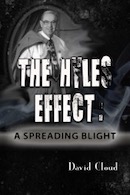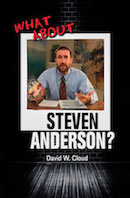866-295-4143, fbns@wayoflife.org
Seattle’s Lucy exhibit is losing a ton of money, because the expected crowds have not materialized. It has been such a financial fiasco that other U.S. cities that were planning to host the exhibit are backing out. Lucy’s bones will probably return to Ethiopia when the Seattle exhibit ends.
The fossilized bones called Lucy consist of a partial skeleton about the size of a chimpanzee that was discovered in 1974 in northern Ethiopia by Donald Johanson and his colleagues.
The discovery is said to be “the key piece in evolution’s puzzle.” They named the fragmentary skeleton “Lucy” after playing the Beatles song “Lucy in the Sky with Diamonds” repeatedly at the camp rock & roll party the night of the discovery. Evolutionists think that Lucy was a member of proto-humans called Australopithecus that lived about three million years ago. Lennon’s 1971 song “Imagine” would have been more suitable, as Johanson and crew were living out the former Beatles headman’s vain dream that there is no God, no heaven or hell, only blind evolution. In the chorus, Lennon sang, “You may say that I’m a dreamer, but I’m not the only one/ And some day I hope you’ll join us/ And the world will be as one.” The evolutionary scientists are at the forefront of pushing this dream of a world united in damnable myth.
What they did not explain at the Museum of Man or the Lucy Legacy exhibit is that the real evidence that this fossil is “proto-human” is non-existent.
Lucy is a hoax, just like the rest of the evolutionary tree. The full-flesh recreations of how Lucy supposedly looked at the Museum of Man, the Lucy Legacy, the St. Louis Zoo, and other places depict a creature that walked upright and had the face, hands, and feet of a half-human, half-ape evolutionary monster, but there is no certain evidence for any of this. It is speculation and therefore completely unscientific.
In fact, the evidence that Lucy’s hands and feet were ape-like and not human-like as shown in the museum models is overwhelming. While Lucy’s founder Donald Johanson strongly argues that Lucy walked bipedially, and has even altered some of bones to fit his theory, it must be recalled that Johanson has too much of a personal stake in the matter to be unbiased. He has become famous simply on the basis of being the discoverer of the Lucy bones.
In 1984, Charles Oxnard, professor of anatomy and human biology and a leading expert on australopithecine fossils, concluded, “The australopithecines known over the last several decades from Olduvai and Sterkfontein, Kromdraai and Makapansgat, are now irrevocably removed from a place in a group any closer to humans than to African apes and certainly from any place in a direct human lineage. All this should make us wonder about the unusual presentation of human evolution in introductory textbooks, in encyclopedias and in popular publications” (The Order of Man: A Biomathematical Anatomy of the Primates, p. 332.)
In 1987, Oxnard did an extensive computer analysis of the existing bones of the Australopithecus and concluded that it walked like an ape, not a man.
In 1984, Oxnard stated in his book The Order of Man, “... the australopithecines known over the last few decades from Olduvai and Sterkfontein, Kromdrai, and Makapans-gat, are now IRREVOCABLY REMOVED FROM A PLACE IN THE EVOLUTION OF HUMAN BIPEDALISM, possibly from a place in a group of any closer to humans than the African apes and certainly from a place in the direct human lineage” (The Order of Man, p. 332).
Dr. Solly Zuckerman, for many years the head of the Department of Anatomy of the University of Birmingham in England and a scientific adviser to the highest level of the British government, said of the Australopithecus that “THEY ARE JUST APES” (Roger Lewin, Bones of Contention, 1987, p. 164). Zuckerman studied the fossils of this creature for 15 years in minute detail with a team of scientists.
In 1993, Christine Tardieu, an anthropologist, reported that Lucy’s “locking mechanism was not developed.” Humans have a locking mechanism in our knees that allow us to stand upright comfortably for long periods of time. Lucy didn’t have that, so she certainly didn’t stand around nonchalantly like she is depicted in the museums.
In 1994, J.T. Stern, Jr., told the 63rd Annual Meeting of the American Association of Physical Anthropologists that he believes that A. afarensis “walked funny, not like humans” (Gish, Evolution: The Fossils Still Say No, p. 257). The Journal of Human Evolution reported that a biochemical study of the hip and thigh of the Australopithecus had concluded that it did not walk uprightly (Christine Berge, Journal Human Evolution, 1994, pp. 259-273).
In 1995, Science News reported that a partial skeleton of an A. africanus had been found “whose ‘apelike’ body was capable of only limited two-legged walking” (Gish, p. 257). This was found in Sterkfontein, where the original Australopithecus africanus was discovered. The pelvis was “generally ape-like in shape.”
In 2000, Nature magazine reported, “Regardless of the status of Lucy’s knee joint, new evidence has come forth that Lucy has the morphology of a knuckle-walker” (Richmand and Strait, “Evidence that Humans Evolved from Knuckle-Walking Ancestor”).
In 2000, Science magazine reported the same thing, that Lucy “has the morphology that was classic for knuckle walkers” (E. Stokstad, “Hominid Ancestors May Have Knuckle Walked”).
In 2007, anthropologists at the Tel Aviv University, said that they have disproven the theory that Lucy is a common ancestor of humans and great apes. “The specific structure found in Lucy also appears in a species called Australopithecus robustus. Prof. Yoel Rak and colleagues at the Sackler School of Medicine’s department of anatomy and anthropology wrote, ‘The presence of the morphology in both the latter and Australopithecus afarensis and its absence in modern humans cast doubt on the role of [Lucy] as a common ancestor.’ ... Rak and colleagues studied 146 mature primate bone specimens, including those from modern humans, gorillas, chimpanzees and orangutans and found that the “ramus element” of the mandible connecting the lower jaw to the skull is like that of the robust forms, therefore eliminating the possibility that Lucy and her kind are Man’s direct ancestors” (Dave Scot, “Icon of Evolution ‘Lucy’ Bites the Dust,” Uncommon Descent, April 26, 2007).
In 2009, anthropologists gathered at the Institute of Human Origins in New York to discuss Lucy, and a report in the New York Times made the following interesting conclusion: “The debate over whether the primate Lucy actually stood up on two feet three million years ago and walked--thus becoming one of mankind’s most important ancestors--has evolved into two interpretive viewpoints, three family trees, spats over four scientific techniques and too many personality clashes to count. ... The long and short of it is, according to a participant, that bipedality lies in the eye of the beholder” (“Did Lucy Actually Stand on Her Own Two Feet?” New York Times, Aug. 29, 2009).
Thus, there is strong evidence that Lucy did not walk uprightly. It is probable that she walked on all fours like an ape, while walking upright for short distances. One day in Kathmandu in 2008, I saw a rhesus macaque monkey walk a long distance on his back legs. Apes can walk upright, but they aren’t designed to do it comfortably and naturally like a man does; they are more comfortable climbing trees.
When it comes to Lucy’s hands, all authorities agree that they were ape-like, and as for her feet, Dr. Randall Susman and Dr. Jack Stern of the State University of New York at Stony Brook, described them as “showing a retention of grasping tendencies with long and curved digits” (New York Times, Aug. 29, 2009). That sounds like ape’s feet to me.
Dr. Stern concluded that everything about Lucy, from her fingertips to her toes, suggests that “our ancestors, after they diverged from apes, inhabited the trees three to four million years ago.” If our “ancestors” supposedly diverged from apes, why did they still have an ape-brain, an ape-body, and still live in trees? Why not admit that the evidence shows that Lucy was an ape and that an ape has always been an ape and humans have always been humans? The reason is that most evolutionary scientists approach this subject from a naturalistic bias, and no amount of evidence will make them believe in divine creation and submit to the authority of the Bible.
The lack of indisputable evidence that Lucy walked uprightly and the clear evidence that Lucy had ape-like hands and feet prove the existence of a hoax that is being perpetrated by evolutionists. Artistic renderings typically depict Lucy with human hands, walking uprightly on human feet. This is true for the models at the New York Museum of Natural History, the American Museum of Natural Sciences, the Museum of Man in San Diego, the National Museum of Anthology in Mexico City, the St. Louis Zoo, the University of New Mexico, and Michigan State University. You can also find drawings of Lucy in science textbooks that depict her walking uprightly with human hands and feet. An example is Life: The Science of Biology by Purves, Orians, and Heller, 1992, p. 604. These models and drawings are not scientific; they are brainwashing tools.
Lucy is an apt name. Just as the Beatles’ song “Lucy in the Sky” lends itself to various interpretations, according to the perspective of the hearer, so do the evolutionist’s bones. When it comes to the ape-man myth, their bias speaks as loudly as a stack of rock & roll speakers.
- Receive these reports by email
- www.wayoflife.org
______________________
Sharing Policy: Much of our material is available for free, such as the hundreds of articles at the Way of Life web site. Other items we sell to help fund our expensive literature and foreign church planting ministries. Way of Life's content falls into two categories: sharable and non-sharable. Things that we encourage you to share include the audio sermons, O Timothy magazine, FBIS articles, and the free eVideos and free eBooks. You are welcome to make copies of these at your own expense and share them with friends and family. You may also post parts of reports and/or entire reports to websites, blogs, etc as long as you give proper credit (citation). A link to the original report is very much appreciated as the reports are frequently updated and/or expanded. Things we do not want copied and distributed are "Store" items like the Fundamental Baptist Digital Library, print editions of our books, electronic editions of the books that we sell, the videos that we sell, etc. The items have taken years to produce at enormous expense in time and money, and we use the income from sales to help fund the ministry. We trust that your Christian honesty will preserve the integrity of this policy. "For the scripture saith, Thou shalt not muzzle the ox that treadeth out the corn. And, The labourer is worthy of his reward" (1 Timothy 5:18). Questions? support@wayoflife.org
Goal:Distributed by Way of Life Literature Inc., the Fundamental Baptist Information Service is an e-mail posting for Bible-believing Christians. Established in 1974, Way of Life Literature is a fundamental Baptist preaching and publishing ministry based in Bethel Baptist Church, London, Ontario, of which Wilbert Unger is the founding Pastor. Brother Cloud lives in South Asia where he has been a church planting missionary since 1979. Our primary goal with the FBIS is to provide material to assist preachers in the edification and protection of the churches.
Offering: Offerings are welcome if you care to make one. If you have been helped and/or blessed by our material offerings can be mailed or made online with with Visa, Mastercard, Discover, or Paypal. For information see: www.wayoflife.org/about/makeanoffering.html.





